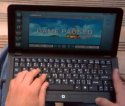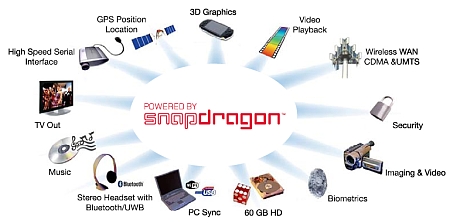Qualcomm spins 1.3GHz Snapdragon
Jun 1, 2009 — by Eric Brown — from the LinuxDevices Archive — 1 viewsQualcomm has announced a new 45-nm fabricated entry in its “Snapdragon” family of chipsets, targeting smartphones and a newly announced category of small-scale netbooks called “smartbooks.” The QSD8650A includes an ARM-based, 1.3GHz applications processor, 2D/3D graphics accelerators, and “up to 30 percent lower” power consumption, the company says.
Qualcomm is promoting the Snapdragon QSD8650A's use in a new wave of ARM-based netbooks, which it prefers to call “smartbooks.” (Ironically, Intel and Psion reportedly just reached an out-of-court settlement regarding the former's use of the trademarked term “netbook.”)
 Prototype of Snadragon-based “smartbook” (Source: Qualcomm) (Click for details) |
More than 30 Snapdragon-based products are now under active development, says Qualcomm. This week at the Computex show in Taiwan, the company is expected to show off a number of Snapdragon-based smartbooks due to ship this Fall. In addition, today several vendors of Linux- and Android-ready software also announced support for Snapdragon-based smartbooks. With the first QSD8650A chipsets not expected to sample until later this year, the first wave of smartbooks will likely be based on earlier Snapdragon versions.
With the faster 1.3GHz clock speed, the QSD8650A offers 30 percent higher performance than previously released Snapdragons, says Qualcomm. Additionally, thanks to 45nm process technology, the chipset offers “unmatched” standby power of less than 10 milliwatts, and up to 30 percent lower dynamic power, the company claims.
In addition to its faster processor and faster bus speed, the QSD8650A chipset also offers multi-mode UMTS and CDMA 3G mobile broadband connectivity, integrated GPS, and Bluetooth 2.1, according to Qualcomm. To be offered in the same 15 x 15mm package as current Snapdragon chipsets, the QSD8650A includes a standalone, power-efficient 2D graphics accelerator and an enhanced 3D graphics core, capable of supporting high-resolution WXGA mobile displays and delivering better performance with Adobe Flash, the company adds.
Background
Qualcomm unveiled its first Snapdragon chipsets, the QSD8250/8650, in November 2007. According to Qualcomm, the QSD8250 offers HSPA data rates of up to 7.2Mbps on the downlink and 5.76Mbps on the uplink, with full backward compatibility. The dual-mode QSD8650 offers HSPA, as well as CDMA2000 1xEV-DO Rev. B, again backward-compatible with WCDMA and GSM/GPRS/EDGE.

Qualcomm's Snapdragon chips offer a wide array of functionality
(Click to enlarge)
Both chipsets include an ARM-based 1GHz “Scorpion” microprocessor with 128-bit SIMD (single instruction multiple data) capability, plus a 600 MHz low-power, “low-leakage” DSP. According to Qualcomm, they also offer WiFi, Bluetooth, and a “universal broadcast modem” that can receive broadcasts in MediaFLO, SDMB, ISDB-T, TDMB, and DVB-H formats.
Features and specifications listed by Qualcomm for the QD8x50 include the following:
- 1GHz CPU
- 600MHz DSP
- Integrated 3G mobile broadband
- Support for Wi-Fi and Bluetooth connectivity
- Built-in seventh-generation gpsOne engine with standalone- and assisted-GPS modes
- High-definition (720p) video decode, and multiple video codec support
- High-performance 3D graphics — up to 22M triangles/sec and 133M 3D pixels/sec
- Up to WXGA (1280 x 720) display support
- 12-megapixel camera support
- Multiple audio codecs: (AAC+, eAAC+, AMR, FR, EFR, HR, WB-AMR, G.729a, G.711, AAC stereo encode)
- Support for mobile broadcast TV (MediaFLO, DVB-H and ISDB-T)
- Support for Linux, Android, and Windows Mobile,
Qualcomm has also since released the dual-CPU QDS8672, which — like the newly announced QSD8650A — is built using 45nm technology. The QSD8672 includes dual CPUs clocked at up to 1.5GHz and, in addition to the features listed above, is said to add the following:
- Higher-resolution WSXGA (1440 x 900) display support
- High-definition (1080p) video recording and playback
- Support for HSPA+ networks — 28Mbps downloads and 11Mbps uploads
- Supports CDMA2000 1X, 1x EV-DO Rel 0/A/B networks
- Improved 3D graphics — up to 80M triangles/sec and 500M+ 3D pixels/sec
Product plans …
 NTT DoCoMo's T-01A (Click image for further information) |
Qualcomm's Snapdragon was originally touted as enabling a new generation of faster, more powerful smartphones. To date, few Snapdragon-based phones have been released, though one shipping example is the Windows Mobile-based Toshiba TG01, also sold as the NTT DoCoMo T-01A (right). The Toshiba device uses a 1GHz QSD6250, comes with a 800 x 480 display, and has a 3.2 megapixel camera.
Stated Luis Pineda, SVP of marketing and product management at Qualcomm, “This latest addition to the growing family of Snapdragon chipsets will help our customers to develop faster, more power-efficient smartphones and smartbooks. This new 45nm device shows our continued commitment to extending the capabilities of the Snapdragon platform with leading-edge process technology and an expanded list of integrated features.”
Availability
According to Qualcomm, its QSD8650A will begin sampling before the end of this year. While the company has not yet posted additional information on the new chipset, more information on the existing QSD8x50 and QSD8672 is available here.
Additional coverage of the QSD8650A may also be found on our sister site eWEEK.com, here.
This article was originally published on LinuxDevices.com and has been donated to the open source community by QuinStreet Inc. Please visit LinuxToday.com for up-to-date news and articles about Linux and open source.